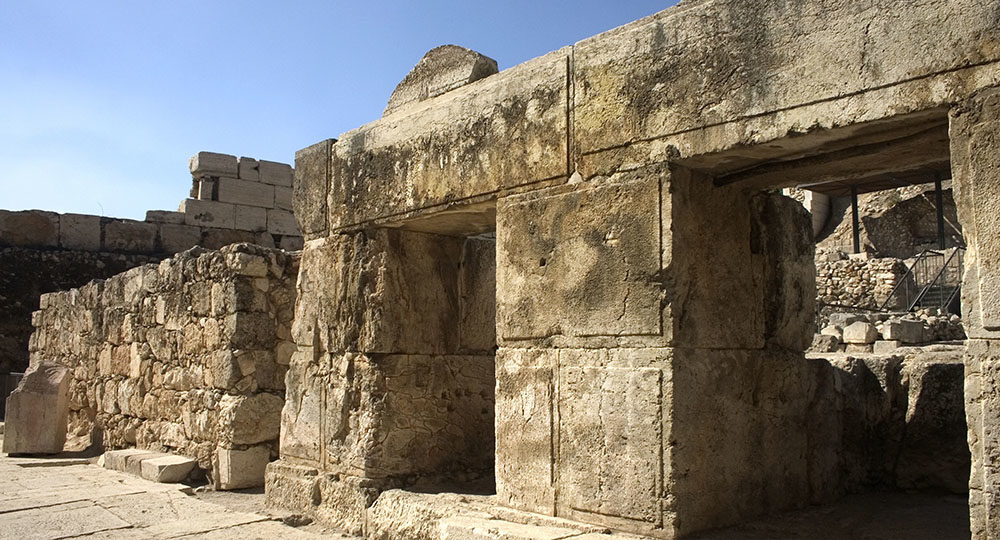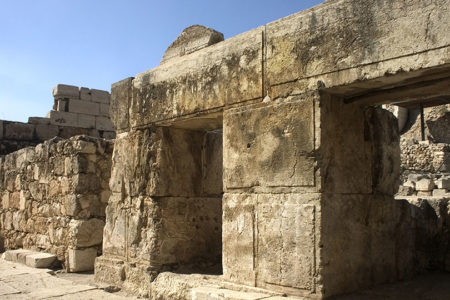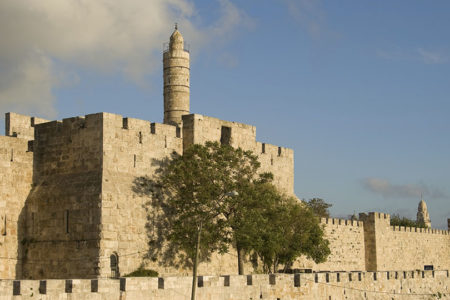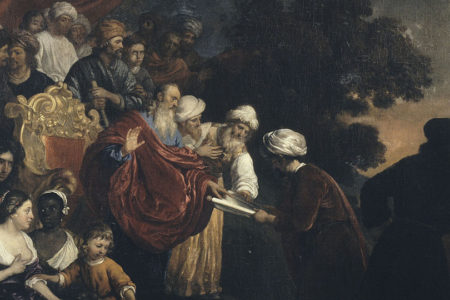The Jewishness of the Temple Mount
I was ushered into a large room with conference tables and bookshelves filled with books on Islamic Law. Sitting at the head of the table, in official attire, was the recently appointed Palestinian grand mufti of Jerusalem, Ikrima Sabri. Behind him hung a portrait of then-Palestinian President Yasser Arafat who had installed him.
I was there to interview the Islamic cleric for a documentary dealing with the religious controversy over the “Haram.” When my question turned to the issue of the Haram being the Jewish Temple Mount, the mufti became agitated. “No Temple ever existed there!” he declared. As proof, he offered this argument: “Had a Temple ever existed on the Haram, Allah would not have commanded Muslims to build a mosque there.” Moreover, he said, “Not a single stone in the entire city proved [an ancient] Jewish existence” in Jerusalem.
His statement reflects the Palestinian revision of history that has become the official history of the Palestinian people. It is taught in every school at every level and is passionately preached from mosque pulpits every Friday by Muslim clerics. The Temple Mount and the issue of rebuilding the Temple are cornerstones of the Israeli-Palestinian conflict.
Most Israelis do not seriously regard the intensity of Muslim feeling toward the prospect of a third Temple. From the torching of the al-Aqsa mosque by a prophetically impassioned “Christian” tourist in 1969 to the opening of an exit to the Western Wall Tunnel in 1995 to the reconstruction of a walkway to the Mughrabi Gate in 2006 to the reconstruction of the Hurva Synagogue in the Jewish Quarter last year, Islamic authorities interpret every act near what they call the Haram al-Sharif as a deliberate attempt by the State of Israel to destroy the Muslim holy places and build a Jewish Temple.
So prolific is the Muslim propaganda denying the ancient Temple’s existence that many Westerners question the Temple’s historicity, as well as the argument for its location on the now-Islamic Haram. It is necessary, therefore, to review the evidence.
What the Bible Says
The Bible unequivocally records the historic existence and topographical location of two Jewish Temples that, throughout Jewish history, have been situated on Mount Moriah. The location first surfaced when God commanded Abraham to offer his son Isaac on a specific mountain in the land of Moriah (Gen. 22:2).
Later God established the Israelites in the land of Israel (2 Sam. 7:10) and told King David, “[your son] shall build a house for My name” (v. 13). The Lord confirmed His choice of the Temple site when He commanded David to purchase the threshing floor of Ornan the Jebusite and erect there an altar for burnt offering (1 Chr. 21:18–29). David declared, “This is the house of the Lᴏʀᴅ God, and this is the altar of burnt offering for Israel” (22:1).
The site was Mount Moriah: “Now Solomon began to build the house of the Lᴏʀᴅ at Jerusalem on Mount Moriah, where the Lᴏʀᴅ had appeared to his father David, at the place that David had prepared on the threshing floor of Ornan the Jebusite” (2 Chr. 3:1).
When the Jewish people returned to Jerusalem from Babylon under the edict of King Cyrus (36:22–23), they built the second Temple exactly where the first had been: “Let the governor of the Jews and the elders of the Jews build this house of God on its site” (Ezra 6:7). They were required to build it “in its place,” meaning on its original foundation (2:68). Theologically, there could be no other location for the second Temple (or any future Temple) than the one historically sanctified by the Divine Presence.
At the first Temple’s dedication, the “glory of the Lᴏʀᴅ” (the Shekinah) filled the Temple’s Holy of Holies (1 Ki. 8:10–12), making the Temple Mount God’s dwelling place forever (v. 13). Also, God showed the prophet Ezekiel that this glory, which had departed before the destruction of the first Temple, would later return as it had departed (Ezek. 9:3; 10:4, 18–19; 11:22–23; 43:1–7). Consequently, the Temple site must remain unchanged until Israel’s final restoration in its land, when God’s presence will dwell within the Temple forever (37:22–28).
What Archaeology Tells Us
Archaeological excavation also unanimously confirms that the present elevated platform Muslims call the Haram is on Mount Moriah and once housed the Jewish Temples.
Although the 10th-century B.C. Davidic and Solomonic kingdoms were once disputed, today archaeological discoveries affirm their historicity. At Khirbet Qeiyafa, a provincial town in the Elah Valley region, archaeologists uncovered impressive fortifications from this period.1 In addition, an ostracon (inscription on a potsherd) in Hebrew from the same period was found in one of the buildings. It reveals a high level of scribal culture that implies the presence of an archive. The site was probably an administrative center now identified as Netaim because of its proximity to the biblical site of Gederah (1 Chr. 4:23).
Archaeology has also uncovered the ancient City of David, which used the remains of earlier Canaanite and Jebusite fortifications and water systems. In southern Jerusalem, on a narrow ridge bordering the Kidron Valley, excavations have revealed a massive, 12-story, stepped-stone structure from the 13th century B.C. upon which David began to build his city.(See 2 Samuel 5:9.) It may have served as a retaining wall, buttressing his Fortress of Zion, since a recent discovery of monumental buildings above has been interpreted as the remains of David’s palace. It was on the elevated extension of a ridge above this palace (the Ophel) that Mount Moriah was situated and the first Temple built by King Solomon, David’s son.
In 2010 a city wall with a gatehouse dating to the late 10th century B.C. was discovered in the Ophel. It shows that sophisticated engineering existed then in the city. A partial inscription in ancient Hebrew on one of several large storage jars unearthed in the complex indicates it belonged to a high-level government official. Seal impressions also argue for a royal context. These discoveries fit well with the biblical record of royal construction that employed skilled Phoenician architects and engineers to build the first Temple (1 Ki. 7:13–14).
Scripture says Solomon “finished building his own house, and the house of the LORD, and the wall around Jerusalem” (3:1). According to Eilat Mazar, the archaeologist who excavated the site, the wall probably connected with the City of David and “goes quite well with the biblical description about King Solomon building the fortification line around the new construction of Jerusalem, which means the temple itself and his royal palace.”2
Scores of clay bullae (small seals stamped with the sender’s name and attached to documents) were discovered in a room in the City of David that was burned when the Babylonians destroyed the first Temple in 586 B.C. Many personal names in the books of Jeremiah and Chronicles were found, including Azariah son of Hilkiah who belonged to the family of high priests that officiated at the end of the first Temple period (1 Chr. 9:11).
An enduring testimony to the ancient Temple is the Western Wall, an extant portion of the second Temple’s retaining wall to which Jewish people for centuries have directed their prayers. This wall extends some 50 feet above the modern plaza, but also another 50 feet below it. Visitors can walk along at least 1,000 feet of this wall through what is known as the Western Wall Tunnels.
In addition, there is Robinson’s Arch. From 1968 to 1978 Israeli archaeologist Benjamin Mazar excavated many structures related to the second Temple, including a great staircase known as Robinson’s Arch, used by the priests to enter the Temple. This monumental structure began at the Pool of Siloam in the Kidron Valley and brought Jewish people (including Jesus and His disciples) up through the Huldah Gates and onto the Temple Mount, as well as to numerous miq-va’ot (ritual immersion pools) used by Jews requiring purification to enter the Temple precincts.
From 1996 to 1998 Ronny Reich excavated in this area. His discoveries included an ancient street lined with shops where Jewish people bought sacrificial animals for the Temple; the landing for Robinson’s Arch; more miqva’ot; and an inscribed stone that instructed the priests where to stand to blow the trumpets signaling the beginning of the Sabbath.
Also lying on this ancient street were tons and tons of the building stones of the Western side of the Temple complex. They had been thrown down from above by Roman soldiers during their assault on the Temple Mount on the 9th of Av in A.D. 70. These stones vividly testify to the Temple’s destruction as predicted by Jesus (Lk. 21:20–24).
Within the context of these architectural structures was found a wealth of artifacts that demonstrated Jewish daily life in and around the Temple.
A preponderance of archaeological evidence verifies the existence of the Jewish Temple and the Jewish people’s long, dominant history in Jerusalem and on the Temple Mount. Ironically, in the past, tourists were given some of these facts by none other than the Muslim authorities themselves.
What Happened?
Islam’s goal to dominate the region and place a Palestinian capital in Jerusalem has demanded rewriting the facts. Islam must destroy the Jewish claim to Jerusalem and to the site of the Muslim holy places. Any Palestinian support of Jewish claims, as Israelis request during peace negotiations, would be tantamount to sedition and punishable by death throughout the Islamic world.
Therefore, it is inconceivable the Palestinians will ever compromise on their demand for total sovereignty over Jerusalem or admit the existence of the Jewish Temples. It remains for those of us who know the facts to tell the truth and stand with the State of Israel in this great war of propaganda that is as pernicious and deadly as any weapons formed by man.
ENDNOTES
- Hershel Shanks, “Newly Discovered: A Fortified City From King David’s Time,” Biblical Archaeology Review 35, no. 1 (2009): 38–43.
- Maayana Miskin, “Dig Supports Biblical Account of King Solomon’s Construction,” Arutz Sheva audio, February 22, 2010 <israelnationalnews.com/news/news.aspx/136130>.







